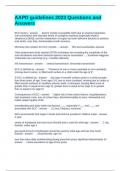AAPD guidelines 2023 Questions and
Answers
ECC factors - answer factors include susceptible teeth due to enamel hypoplasia,
oral colonization with elevated levels of cariogenic bacteria (especially Mutans
streptococci [MS]), and the metabolism of sugars by tooth-adherent bacteria to produce
acid which, over time, demineralizes tooth structure.
Microbial risk markers for ECC include... - answer MS and Lactobacillus species
*New polymerase chain reaction (PCR) techniques are revealing the complexity of the
oral microbiome and other bacterial species may be associated. · ., Scardovia wiggsiae,
Veillonella ssp.) and fungi (e.g., Candida albicans)
MS transmission - answer vertical transmission, horizontal transmission
ECC is defined as - answer "Presence of one or more (cavitated or non-cavitated),
missing due to caries, or filled tooth surface in a child under the age of 6"
S-ECC is defined as - answer any sign of smooth surface caries in a child younger
than three years of age. From ages 3-5, one or more cavitated, missing due to caries or
filled smooth surfaces in maxillary anterior teeth, or decayed, missing filled score of
greater than or equal to four (age 3), greater than or equal to five (Age 4) or greater
than or equal to six (age 5)
Consequences of ECC - answer higher risk of new caries lesions, hospitalizations,
high treatment costs, loss of school days, diminished ability to learn, diminished oral
health related quality of life
breastfeeding and baby bottle use beyond ____ especially if ___ and ____ are
associated with ECC - answer 12 mos, frequent, nocturnal
AHA recommends that sugar in foods and drink be avoided in children under - answer
2 year
smear of toothpaste has how much fluoride and is used for what age - answer .1 mg
fluoride, under age 3
pea sized amount of toothpaste should be used for what age and has how much
fluoride - answer .25mg fluoride, age 3-6
less than twice daily toothbrushing during preschool years significant determinants of -
answer caries prevalence at age of five years
,Recommended professionally applied fluoride treatment for children at risk of ECC who
are younger than 6 years is what fluoride varnish, how much fluoride - answer five
percent sodium fluoride varnish, 22,500 parts per million fluoride
what percentage silver diamine fluoride - answer 38%
which DFS (used to measure prevalence of ECC) component has increased for
preschool children - answer filled, more treatment is being provided
which milks are less cariogenic - answer cows milk, humans milk less sucrose than
formula
when should fluoridated water be introduced - answer six months
low calorie sugars should be avoided until what age - answer age 5
AHA recommends that children under ____ should avoid added sugars - answer 2
years
introduction of sugar based drinks before age ____ was associated with obesity at age
____ - answer age one, age six
juice should not be introduced before age ____ - answer age one
intake of juice should be limited to ____ for ages 1-3 - answer four ounces a day
intake of juice should be limited to ___ for ages 4-6 - answer 4-6 ounces per day
intake of juice should be limited to ___ for ages 7-18 years - answer 8 ounces per
day
nearly ___ of 2-5 year olds consume sugar based drinks daily - answer half
prevalence of caries in primary, perm teeth among children 2-19 is estimated at -
answer 45.8 percent
for children and adolescents aged two through 19, the prevalence of obesity is an
estimated ____, including____ with severe obesity and another ___overweight - answer
19.3 percent, 6.1%, 16.1%
"Added sugars—less than ___% per day starting at age ____. Avoid foods and
beverages with added sugars for those younger than age ____ - answer Less than
10 percent of calories per day starting at age two, two
NSAIDs can exacerbate - answer liver or kidney impairment, extend bleeding time
, Acetminophen can be associated with - answer hepatotoxicitiy
Aspirin is contraindicated in - answer Pts under 18 years with chickenpox or flu-like
symptoms
may cause Reye's Syndrome
restriction of ____ and ___ in children - answer codeine and tramadol
approx ___% of cavitated caries lesions in primary teeth would be expected to be
arrested ____ years after SDF application with once or twice a year application - answer
68%, 2 years after SDF application
SDF had___% higher success rate in caries lesion arrest compared to controls - answer
48%
SDF contains approx ___ weight/volume of silver and ___ percent fluoride - answer
24-28% silver and 5-6% fluoride weight/volume
application time of ___ drying with air is recommended. application times range from
___ seconds to ___ minutes for SDF - answer one minute, 10 seconds to 3 minutes
eating and drinking after SDF - answer it's fine
effectiveness of one time SDF app in arresting caries lesion ranges from ___% to ___
% depending on lesion size, location - answer 47-90%
SDF in the __ teeth arrest at higher rates than ___ teeth - answer anterior teeth
compared to posterior teeth
after single application of ___% SDF, ____% of the arrested surfaces at 6 months had
reverted to active lesions at ___ months - answer 38% SDF, 50% arrested surfaces,
24 months
___ annual application of SDF is more effective in arresting caries lesions than
application of 5% fluoride varnish ___x a year - answer 3 annual app SDF, fluoride
varnish 4x year
frequency of SDF application after baselines: ____ month f/u, then at semiannual recall
visits over ____ years - answer 3 month f/u, semiannual recall over 2 years
monitor caries lesion arrest after SDF application for ____ week period - answer 2-4
week period




